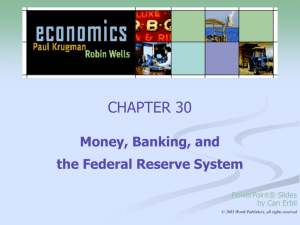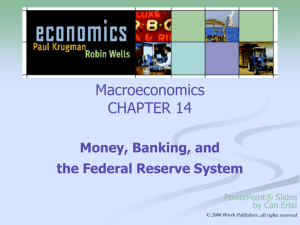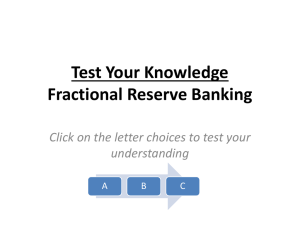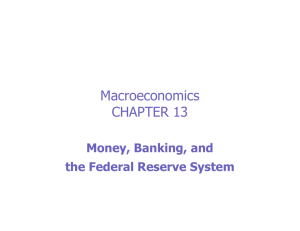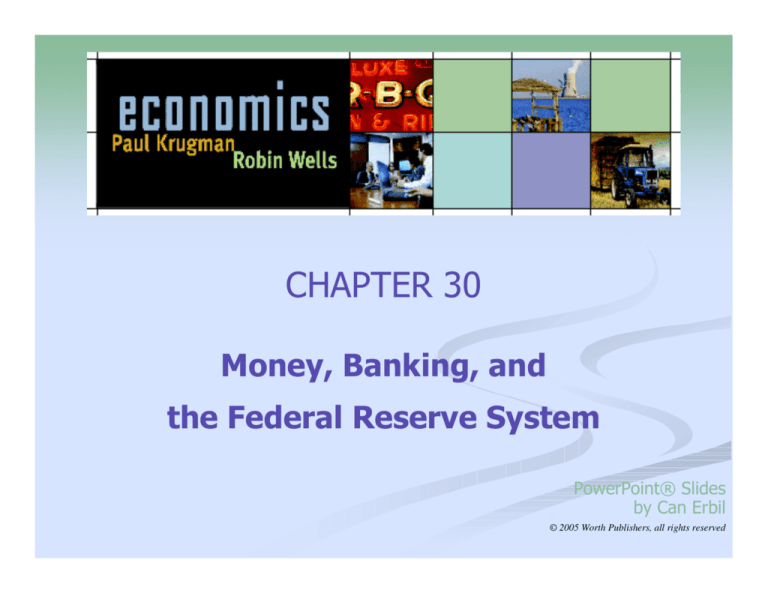
CHAPTER 30
Money, Banking, and
the Federal Reserve System
PowerPoint® Slides
by Can Erbil
© 2005 Worth Publishers, all rights reserved
What you will learn in this chapter:
The various roles money plays and the many forms it takes in
the economy.
How the actions of private banks and the Federal Reserve
determine the money supply.
How the Federal Reserve uses open-market operations to
change the monetary base.
2
Roles of Money
A medium of exchange
An asset that individuals acquire for the purpose of trading
rather than for their own consumption.
A store of value
Holds purchasing power over time.
A unit of account
Measure used to set prices and make economic calculations
3
Types of Money
Commodity money
A commodity-backed money
Fiat money
4
Monetary Aggregates
The Federal Reserve uses three definitions of the money supply:
M1, M2, and M3.
M1 = $1,368.4 (billions of dollars), June 2005
M1 is equally split between
currency in circulation and
checkable bank deposits.
5
Monetary Aggregates
The Federal Reserve uses three definitions of the money supply:
M1, M2, and M3.
M2 = $6,510.0 (billions of dollars), June 2005
M2 includes M1, plus a range
of other deposits and
deposit-like assets, making it
about three times as large.
6
The Monetary Role of Banks
A bank is a financial intermediary.
Bank reserves are the currency banks hold in their vaults plus
their deposits at the Federal Reserve.
The reserve ratio is the fraction of bank deposits that a bank
holds as reserves.
7
Bank Regulations
Deposit insurance
Capital requirements
Reserve requirements
8
Determining the Money Supply
Effect on the Money Supply of a Deposit at First Street
Bank
9
How Banks Create Money
10
Reserves, Bank Deposits, and the Money
Multiplier
Increase in bank deposits from $1,000 in excess reserves =
$1,000 + $1,000 × (1 – rr) + $1,000 – (1 – rr)2 + $1,000
– (1 – rr)3 + . . .
this can be simplified to: Increase in bank deposits from $1,000
in excess reserves = $1,000/rr
11
The Money Multiplier in Reality
The monetary base is the sum of currency in circulation and
bank reserves.
The money multiplier is the ratio of the money supply to the
monetary base.
12
The Federal Reserve System
Board
of Governors = 7 members appointed by the President and
approved by the Senate . Each member serves a 14 year term. The
chairman serves 4 year terms, but traditionally they are reappointed.
New
York Fed carries out open-market operations, the Fed’s main
monetary policy. Decisions about monetary policy are made by the
Federal Open Market Committee (FOMC)
FOMC
= The Board of Governors plus five regional Fed Presidents on a
rotating basis with the exception of the President of the New York Fed
who is a permanent member.
13
What the Fed Does: Reserve Requirements and
the Discount Rate
The federal funds market
Financial market that allows banks that fall short of the
reserve requirement to borrow reserves – usually just
overnight – from banks that hold excess reserves.
The federal funds rate
Interest rate that banks charge for lending overnight to
another bank. Determined by supply and demand, but
strongly affected by the Federal Reserves actions
The discount rate
The rate of interest the Fed charges on loans to banks. 1%
point above the federal funds rate.
14
Open-Market Operations
The Federal Reserve’s Assets and Liabilities:
15
Open-Market Operations by the Federal Reserve
An Open-Market Purchase of $100 Million
16
Open-Market Operations by the Federal Reserve
An Open-Market Sale of $100 Million
17
The End of Chapter 13
coming attraction:
Chapter 14:
Monetary Policy
18


